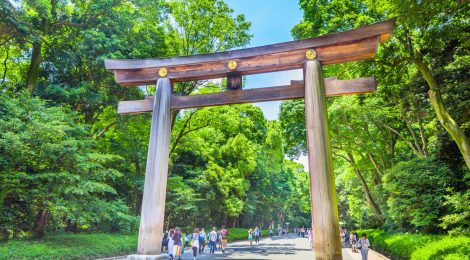
Meiji-jingu Shrine
Where Tokyo’s Modern Pop Culture and Rich History Meet
Tokyo, the bustling capital city of japan, is known for its vibrant pop culture and rich history. One place where these two aspects come together is Meiji Jingu, a Shinto shrine located in the heart of the city. Surrounded by a lush green forest, Meiji Jingu is dedicated to Emperor Meiji (1852-1912) and Empress Shoken, who played a significant role in modernizing Japan.
Visiting Meiji Jingu should be at the top of your list when exploring Tokyo. Whether you’re exploring the trendy district of Shibuya or the quirky neighborhood of Harajuku, a quiet walk through the shrine’s well-trodden paths provides a peaceful contrast to the bustling city streets.
Don’t Miss: Meiji Jingu Museum and the Inner Garden
When visiting Meiji Jingu, there are a few highlights you shouldn’t miss. The Meiji Jingu Museum showcases a collection of articles used by or associated with Emperor Meiji and Empress Shoken. It offers a fascinating glimpse into the lives of these influential figures in Japanese history.
Another must-visit spot is the Inner Garden, often referred to as a “power spot.” This hidden gem within the shrine grounds is a serene oasis filled with beautiful scenery. The garden features traditional Japanese architecture, including a classic tea house, and is particularly famous for its iris gardens. These gardens were often visited by the emperor and empress, adding to the historical significance of the site.
The Spring Grand Festival
If you visit Meiji Jingu during late April or early May, you’ll have the opportunity to experience the shrine’s Spring Grand Festival. This annual event is held to celebrate the arrival of spring and features incredible performances of ceremonial music and dances. It’s a fantastic way to immerse yourself in Japanese culture and witness traditional rituals.
Getting to Meiji Jingu
Meiji Jingu is conveniently located next to Harajuku Station and Meiji-jingumae Station. If you’re traveling by JR, you can take the Yamanote Line to Harajuku Station. If you prefer the metro, catch the Chiyoda or Fukutoshin lines to Meiji-jingumae Station. From either station, it’s just a 10-minute walk to the shrine.
A Century of History
Meiji Jingu has a rich history that dates back to its construction in 1920. The shrine was built to commemorate the virtues of Emperor Meiji and Empress Shoken, who played instrumental roles in Japan’s modernization. Unfortunately, like many other major sites in Tokyo, the shrine’s original buildings were destroyed during World War II. However, thanks to a public fundraising effort, the shrine was rebuilt and continues to stand as a testament to Japan’s history and resilience.
Walking Out of the City and into Nature
As you pass through the bustling streets of Harajuku and make your way towards Meiji Jingu, you’ll find yourself immersed in nature. The short walk to the shrine’s front gates is a tranquil journey, shielded by towering trees that block out the sights and sounds of the city. It’s hard to believe that you’re in the middle of one of the world’s busiest cities as you enter the shrine grounds.
Taking Part in Shrine Traditions
Once you reach the main complex of Meiji Jingu, you can partake in traditional Shinto rituals. English signage is available to guide you through the process, making it accessible for international visitors. You can make offerings and pray at the main shrine, write your wishes on an ema tablet, and even purchase a fortune or amulet for good luck.
The “Power Spot”
To the southern end of the shrine grounds lies the expansive Inner Garden. This often overlooked area is an essential part of the shrine and offers a unique experience. The iris gardens, in particular, hold historical significance as they were frequently visited by the emperor and empress. Kiyomasa’s Well, named after the lord who dug it 400 years ago, is considered a “power spot.” Many people visit this location to receive positive and restorative energy.
Festivals and Events
Meiji Jingu is a center for various festivals and events throughout the year. From New Year’s Day, when millions of visitors flock to the shrine for good fortune, to the end-of-the-year ritual Joya-sai on December 31st, there’s always something happening at Meiji Jingu. The Spring Grand Festival is a particularly exciting time to visit, as you can witness traditional performances and immerse yourself in the vibrant atmosphere.
In addition to the events held at Meiji Jingu, the nearby Yoyogi Park also hosts a variety of modern festivals, food fairs, and performances throughout the year. This park, located next to the shrine, is a popular spot for both locals and tourists alike.
In Conclusion
Meiji Jingu is a must-visit destination for anyone exploring Tokyo. It offers a unique blend of modern pop culture and rich history, making it a fascinating place to discover. From the serene forest paths to the traditional rituals, there’s something for everyone at this iconic Shinto shrine. Whether you’re interested in history, culture, or simply seeking a peaceful retreat from the city, Meiji Jingu is sure to leave a lasting impression on your visit to Tokyo.
Address And Maps Location:
1-1 Yoyogikamizono-cho, Shibuya-ku, Tokyo-to
Subscribe, follow @idbcpr and idbackpacker.com